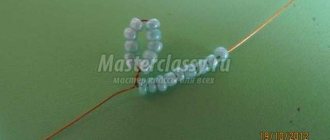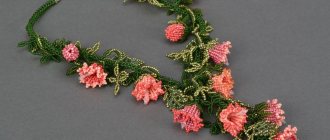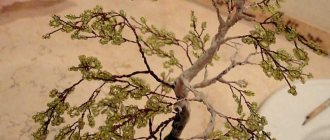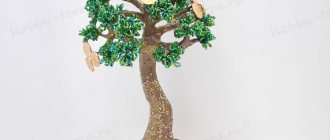Bead products by their nature are very delicate and exquisite things that require painstaking work. And the flowers turn out to be real and alive, but they don’t require constant care and watering.
They remain fresh and beautiful all year round, not just during the flowering season. Let's take a closer look at how to weave a gladiolus from beads; the master class will help you with this. Gladiolus has symbolized victory since ancient times, as its leaves look like swords.
From Latin, "gladiolus" is translated as "small swords." This flower is tall and sophisticated, with lush inflorescences.
So, let's start the master class on weaving gladiolus. It is difficult to make this flower, since it is woven using the French technique or, as it is otherwise called, the arc weaving technique.
Simple difficulties
For beginners, there is a detailed step-by-step method for weaving a gladiolus. To work you will need:
- small green beads of different shades;
- white beads;
- pink beads of several shades;
- wire;
- thick wire for the stem;
- Florenta.
Gladiolus is a large and massive flower, even a whole inflorescence. Therefore, in order for the petals to take shape well and not fall, you can resort to a little trick. Instead of the classic base for weaving with an arc, you can make a cross, as shown in the diagram.
The colors of the beads can be combined at your discretion. It will look more natural if you make dark tones on the inside and lighter tones on the edges.
For one flower you need to make 5 petals, which are shown in the diagram.
There should be such petals:
- No. 1 – 1 piece;
- No. 2 – 2 pieces;
- No. 3 – 2 pieces;
- No. 4 – 1 piece.
Moreover, the petals numbered 3 and 4 are curly. They are made by arc weaving, and wavy edges are made along the perimeter of the petal. With this type of weaving, the wire is attached not from above, but below, turning in the opposite direction.
Next you need to sort the resulting petals by type. Quantity is not limited. You need to do as much as you think is necessary for a beautiful flower.
Then we begin to collect the flower, folding the petals one by one. To prevent them from falling apart, you need to twist the ends of the wire.
To make the flower look natural and similar to the real one, you need to make stamens. You can use needle weaving.
In living nature, it is rare that all the flowers will be in bloom, which means you need to make a couple of buds. You just need to weave slightly smaller petals. Here you can let your imagination run wild. Make some buds very small and closed, and some half-closed. When everything is done, they will need to be twisted, as well as the ends of the wire, attaching the stamens.
Next according to the diagram are the leaves.
The two leaves will need to be connected to each other, and a flower inserted in the center. Correct and straighten everything beautifully so that the flower looks beautiful and natural.
We do the same with closed and semi-closed buds.
Now all that remains is to plant the gladiolus, that is, weave a lot of green leaves. The technique of execution is still the same - arc. The main thing here is to diversify the leaves. Make a lot of them and of different sizes, because in nature there are no identical and straight leaves. And it’s the same here: the more leaves, the better the final composition will look.
Now all the elements are ready, all that remains is to put the flower together. At the very top there will be closed buds, then half-closed. And gradually, as if blossoming, you begin to weave open gladiolus flowers. There will be green leaves at the very bottom.
If you make several of these single flowers, you can make a whole bouquet of gladioli. They can be placed in a vase like real flowers. They will decorate any room. Or you can use them as a gift.
Video on the topic of the article
- If you suddenly have any questions or inaccuracies, then from the video it will become absolutely clear how to weave a gladiolus from beads.
Source: https://DekorMyHome.ru/rukodelie/kak-splesti-gladiolys-iz-bisera-master-klass-dlia-nachinaushih-s-video.html
Detailed master class on weaving gladiolus from beads
To weave these beautiful flowers, prepare the following materials:
- green beads;
- white beads, as well as light pink;
- the wire is thin and thick;
- ribbon for floristry.
The basis of weaving will be the well-known French technique, which has been described more than once on our website. We invite you to familiarize yourself with the diagram that will be used in this master class.
You can combine the color palette of beads the way you want. It can be a dark center and light edges, or exactly the opposite.
One copy consists of 6 petals. The photo shows the petals by number; they need to be woven in the following quantities: the first in a single copy, the second in two copies, the third in two, and the fourth in one.
Beading of blanks occurs in the shape of an arc. The openwork edge is formed by fastening the wire not from above, but slightly before reaching it, with a turn back. When the components are ready, you need to arrange them in piles, according to their individual shape and type. The whole process can be seen in the presented photo.
Now you can begin assembling the gladiolus. Fold the petals as in the picture, and then twist the edges of the wire. Then construct the stamens by needle weaving. They should look like this photo.
In addition to the opened buds, you will also need to weave the unopened ones. This will require fewer elements. Once everything is ready, twist the buds and attach the stamens to them.
Well, what is a flower without sepals? For gladiolus you will also need to weave them. Then connect these blanks together, and place the main structure in the center. Spread the craft with your own hands so that it looks beautiful and natural. Do the same with the smaller buds.
All that remains is to make green foliage from beads. The arc weaving technique again also remains and will be used in this last stage of the master class. You need to make leaves of different heights and widths. The more you weave them, the more magnificent your chic bouquet will look.
Now let's form one branch for example. At the top of the product you should attach small buds with foliage, and then, going lower and lower, increase their size to large specimens.
By making a whole bouquet of beads, you can make a whole composition and put it in a vase so that even no one can distinguish them from real flowers. Therefore, the result depends only on you. Approach this skill with great enthusiasm and faith in your abilities. Carefully follow the diagram and photo instructions. Only in this case will you succeed. Another weaving option can be seen in the video that will be shown in this article.
Beaded gladiolus in a step-by-step master class (photo)
Gladiolus is a tall and slender flower with sharp long leaves and lush flowers. It looks great in bouquets in a vase.
Making a gladiolus from beads is not so easy, especially if you want to convey all the beauty of this “victor’s flower,” because that’s what people also call it.
To weave its leaves and petals you will need manufacturing diagrams and a visual master class.
Having learned how to weave one of the flower prototypes from beads, you can easily weave another: let it be the lush color of lilac or tremulous poppies.
Materials and accessories
To start weaving gladioli from beads, you need to stock up on materials and tools:
- Green beads in two shades – about 50 g;
- Pink beads are available in several shades – 80-100 g;
- White or yellow beads for stamens – 20 g;
- Wire for weaving, diameter 0.3 mm;
- A rod with a diameter of 4 mm is about 70 cm;
- Wire cutters, pliers;
- Green floss threads or florente;
- PVA glue;
- Ruler, scissors (if necessary).
Our master class will look at how to weave a gladiolus with French arches, although other patterns can be used. The future flower will consist of three unopened buds, two half-opened, two small flowers, and three larger ones.
Master class on weaving gladiolus from beads
Leaf weaving technique
Mastering gladiolus beading is not that difficult. We take a 45 cm wire, make a loop from one end, and collect beads from the other to take up two-thirds of the wire. At the free end you also need to make a loop with beads 10 cm long.
How to weave a gladiolus from beads in a step-by-step master class
To make a gladiolus from beads you don’t have to spend a lot of time and effort. Even those who are new to needlework can cope with this work. Before starting work, you must prepare all the necessary materials and tools. You will need:
- approximately 100 grams of pink beads;
- approximately 40-50 grams of beads in green shades;
- white cutting or beads;
- copper wire with a diameter of no more than 0.4 mm;
- a spitz can be used as a rod;
- floss threads or green floral ribbon;
- PVA glue;
- scissors.
And if you want to decorate your flower beautifully, you will need a flower pot, alabaster, as well as decorative stones of different colors and shapes.
Progress.
Our gladiolus will consist of several unopened buds and several already opened flowers. Below is a detailed master class and diagrams, thanks to which you can easily make a beautiful flower from beads with your own hands.
First we will weave a leaf from green beads. To do this, we will use the technique of weaving with arcs. Cut a piece of wire from the coil so that its length is approximately 40-45 centimeters. Make a loop at one end of the wire, and string beads on the other end. String the beads two-thirds the length of the wire. After all the beads are strung on the free end of the wire, make a loop consisting of beads, about ten centimeters long.
Now twist all the ends of the wire several turns. The length of the free edge must be at least 8 centimeters. This loop will be the central base for our sheet. Next, you need to wrap 3 arcs on each side around the base of the sheet. In order for the sheet to be jagged, we will fix the following arcs not on the central axis, but at the middle of the outermost arc. We weave arcs symmetrically on the other side of the sheet.
After completing all the steps, you will receive a jagged leaf made of green beads, as in the photo. For our bouquet you will need five of these leaves.
Now weave the petals from pink beads in the same way. We will need them for buds. Therefore, their number should be equal to the number of buds in the bouquet.
We weave green leaves again, only this time they are not jagged. We will need these leaves to make sepals. Let's form a loop on the wire in the same way as in previous times. Now put about 10 beads on the wire, on the edge of which there is a loop. Once the central axis is formed, weave several arcs around it. In our case, we made 4 arcs on each side.
Now let's create smaller pink petals in the same way. To do this, we will make the axis shorter, i.e. We collect not 10, but 8 beads.
And for a large flower we will weave larger petals in the same way. Therefore, we will string 11 and 12 beads onto the main axis. The width of the petals should be 5 and 6 pairs of arcs, respectively. For a bouquet you will need three pieces of each petal. While weaving, you can experiment with the coloring of the petals to make the flowers more natural.
The petal weaving pattern looks something like this:
Gladiolus made of beads: master class with photos. Gladiolus flower beading pattern for beginners
Author of the master class: annmouse (Anna)
Material for one gladiolus:
- beads No. 10 pink - approximately 80g;
- beads No. 10 green - approximately 50g;
- cutting or beads No. 8 white - approximately 15g;
- working wire d=0.3mm;
- umbrella needle (about 60cm);
- threads of floss to match the green beads - approximately 20m;
- PVA glue;
- scissors.
The method of execution is weaving with arcs (if desired, you can find a description of the technique). Work progress. A gladiolus branch consists of 3 green buds, 2 opening buds, 2 small flowers, 3 large ones.
1. On a wire 1 m long we make a serrated sheet.
Make a small loop at one end of the wire and twist the wire under the loop several times. Place beads on about 2/3 of the wire. At the free end of the wire we make a loop, 8-10 cm long, leaving a free end of the wire 7 cm long - you should get the central axis of the sheet. We string 12 beads onto it. Then we begin to wrap the strung beads (the second end) around the axis counterclockwise. We perform 4-5 pairs of arcs. Next, we perform not circular, but return arcs. The low is fixed not on the axis, but on the previous arc (approximately in the middle) with an indent of several beads from the place where the previous arc was attached. The wire is inserted from the wrong side to the front. Next, we return to the bottom of the axis and secure the arc. The next return arc is performed symmetrically about the axis. You need to make 5 leaves.2. Using the same principle, we make 2 pink petals.3. We make sepals for the flowers. We string beads onto the wire and weave arcs. The leaf consists of 4 pairs of arches. We collect 10 beads on the central axis.4. We make petals for a small flower. The central axis is 8 beads, 4 pairs of arcs. You need to make 8 pieces (for 2 flowers).5. A large flower consists of 6 petals:
Three petals with an axis of 11 beads, 5 pairs of arcs and three petals with an axis of 12 beads, 6 pairs of arcs.
Those. for three large flowers, we need to make 9 petals of different sizes.6. There are two types of stamens. They are made on a wire 20 cm long. a) We string 30 beads, make a loop of 7 beads and pass in the opposite direction through the remaining ones. You need to make 5 pieces. b) We string 25 beads, a loop - 5 beads. There are 3 stamens in the flower: 1 large, 2 small. Assembly.
Rolling the buds Shaping the petals
We wrap floss threads around the wire using glue at a distance of 1.5-2 cm from the bud, strengthen the bud if necessary. Collecting flowers A small flower is formed immediately. 1 cm of floss is wrapped and 2 sepals are attached, the wire is also wrapped by 1.5 cm. The large flower is assembled gradually: first the stamens and small petals (of 5 arcs), then a couple of mm of wire is wrapped, then large petals are attached one at a time in the spaces between the small ones, the wire is again wrapped to 1 cm, the sepals are attached, the wire is again wrapped to 2 cm. Assembling the branch.
A green bud is attached to the rod (spoke). We wrap the wire 2.5-3 cm. We fasten the next bud, after 1 cm the next bud in a checkerboard pattern. We continue to wrap the branch. After 2 cm we attach a small flower, after 1 cm another. Next, after 3-4 cm, large flowers are attached. The stem is wrapped with threads, which are secured with glue.
PS Buds and flowers are arranged in a checkerboard pattern. For greater strength, the place where the flower is attached is smeared with glue. And one more thing. Pay attention to how you arrange the buds: some bunch up the top, some attach the flowers too far from the stem, all of this is a mistake. The flower will look bad. Before each pinning of an element, take the time to see what it looks like. Source 1: annmouse. blogspot. . . . 09/10/blog-post_3932. htmlSource 2: biser. info / node / 37952Viewing this content is allowed only to registered users.Register
After registration, you will have access to extended functionality.
Source: https://itsmy.art/world/artbiser/biseropletenie/masterklass-gladiolus-2775
Video: Learning to weave jagged leaves from beads
Sepals
We string green beads onto the wire and secure one end with a loop. 10 beads are strung on the sepal axis and three arcs are twisted.
Petals for small buds
The pattern remains the same, the only change is the number of beads on the axis. Green leaves will require 10 beads to be strung on the axis, and flowers will require 8 beads. We weave 8 leaves and 2 flowers.
Petals for large flowers
The leaves here do not differ from those that were woven for small flowers, the only difference will be the number of beads on the axis - 11, the number of arcs - 5 instead of 3. Weave three leaves.
The large flower consists of nine petals. Therefore, weave three more petals, but their central axis will already have 12 beads entwined with six arcs.
Stamens
The stamens will help make the beaded gladiolus look like a real one. They must have different lengths and be made in two ways:
- We string 30 beads onto a 20 cm long wire. Having determined the middle, you need to make a loop with seven beads, and draw one of the ends through the unused beads. We make 5 of them;
- We collect 25 beads onto the same piece of wire. We put 5 beads on the loop in the middle and pass the end of the wire through the remaining beads. We make 10 stamens. This completes the beading of the gladiolus, all that remains is to assemble the flower.
Formation of buds
First, we roll the pink petal into a bud, and then we wrap it on top with green and jagged green. If it is not entirely clear how to do this, you can look at photos and video materials.
The tip of the finished bud must be wrapped with floss downwards by 2 cm. To strengthen it, you can attach a piece of wire of a larger diameter. The thread is glued with PVA glue.
Collection of flowers
So, our master class is coming to an end, let's move on to assembling the gladiolus with our own hands.
Give the leaves the desired shape by bending them inward. These will be unopened gladiolus flowers. Large flowers that have already bloomed should be bent in the other direction.
To collect a small bud, take 1 long stamen, two short ones for the middle. We wrap them with floss, attach 4 petals in pairs, wind the thread, and attach the sepals. Wrap the end of the wire well with threads 2 cm down and glue with PVA glue.
For a large bud, take the stamens and fasten them with thread. Then we begin to attach the petals. First, we wind three pieces that have an axis of five beads. Next, petals with an axis of 12 beads are attached in turn at intervals. After wrapping the trunk by 2 cm, we secure the sepals and again mask the trunk with thread.
Attaching flowers to the trunk
At the end, our master class will talk about the location and fastening of gladiolus buds on the stem. We place a bud at the very top of the trunk and a second bud 1 cm below. Please note that the gladiolus buds should be placed on the trunk in a checkerboard pattern, the distance between them should be about 1.5-2 cm, but the further you move down, the distance should increase by 0.5 cm. It is better to look at this moment in the photo to do everything beautifully and correctly. The barrel must be completely wrapped with tape or thread.
That's all, our beaded gladiolus is ready. You can collect several of these branches and place them in a beautiful vase.
Beaded Gladiolus
- Materials:
- - beads: pink, white, lilac, green,
- - wire - 0.3 mm,
- - a slightly thicker wire -0.4-0.5 mm - for the stem,
- - green threads - for winding the stem.
- First we need to weave the petals:
Take a 100cm wire, fold it in half so that one end is 20 centimeters, then twist the long end of the wire two or three turns in the middle of the short end of the wire. The result is a loop with protruding ends - one is 70 centimeters, the second is about 10.
Step-by-step master class on weaving gladiolus from beads
Translated from Latin, the gladiolus flower sounds like “small sword” , since for a long time it has reminded people of this very object because of its lush flower and long pointed leaf. This is why gladioli are considered masculine flowers and are a symbol of victory and courage.
Therefore, we decided to offer you an interesting training master class on beadwork . The article will show step-by-step photos, weaving patterns and video tutorials.
Detailed master class on weaving gladiolus from beads
To weave these beautiful flowers, prepare the following materials:
- green beads;
- white beads, as well as light pink;
- the wire is thin and thick;
- ribbon for floristry.
The basis of weaving will be the well-known French technique, which has been described more than once on our website. We invite you to familiarize yourself with the diagram that will be used in this master class.
You can combine the color palette of beads the way you want. It can be a dark center and light edges, or exactly the opposite.
One copy consists of 6 petals. The photo shows the petals by number; they need to be woven in the following quantities: the first in a single copy, the second in two copies, the third in two, and the fourth in one.
Beading of blanks occurs in the shape of an arc. The openwork edge is formed by fastening the wire not from above, but slightly before reaching it, with a turn back. When the components are ready, you need to arrange them in piles, according to their individual shape and type. The whole process can be seen in the presented photo.
Now you can begin assembling the gladiolus. Fold the petals as in the picture, and then twist the edges of the wire. Then construct the stamens by needle weaving. They should look like this photo.
In addition to the opened buds, you will also need to weave the unopened ones. This will require fewer elements. Once everything is ready, twist the buds and attach the stamens to them.
Well, what is a flower without sepals? For gladiolus you will also need to weave them. Then connect these blanks together, and place the main structure in the center. Spread the craft with your own hands so that it looks beautiful and natural. Do the same with the smaller buds.
All that remains is to make green foliage from beads. The arc weaving technique again also remains and will be used in this last stage of the master class. You need to make leaves of different heights and widths. The more you weave them, the more magnificent your chic bouquet will look.
Now let's form one branch for example. At the top of the product you should attach small buds with foliage, and then, going lower and lower, increase their size to large specimens.
By making a whole bouquet of beads, you can make a whole composition and put it in a vase so that even no one can distinguish them from real flowers. Therefore, the result depends only on you.
Approach this skill with great enthusiasm and faith in your abilities. Carefully follow the diagram and photo instructions. Only in this case will you succeed.
Making slender gladioli from beads
Gladiolus is a tall and slender flower with sharp long leaves and lush flowers. It looks great in bouquets in a vase. Making a gladiolus from beads is not so easy, especially if you want to convey all the beauty of this “victor’s flower,” because that’s what people also call it. To weave its leaves and petals you will need manufacturing diagrams and a visual master class.
Having learned how to weave one of the flower prototypes from beads, you can easily weave another: let it be the lush color of lilac or tremulous poppies.
Gladiolus from beads weaving according to photo-video master class
Beadwork allows you to create amazing crafts, including all kinds of flowers that can easily decorate any interior.
If you want to add to your florist collection, then we suggest you weave slender and tall gladioli from beads. A fascinating master class with detailed photos awaits you.
Even novice craftswomen will be able to repeat the entire manufacturing process from start to finish.
How to weave a gladiolus from beads
Here is a list of materials you will definitely need:
- you will need beads of white, light yellow, pink, lilac, silver and green;
- thin and thick wire;
- green floss threads;
- nippers with scissors.
As with most flower weaving, this project will also use the French technique. We will start weaving from the upper side petal.
Cut a thin wire sixty centimeters long and string fifteen beads onto it. You will have the base. Continue weaving until you have a blank consisting of eight rows of beads.
The photo shows the finished gladiolus element. You should make two of these purple ones with your own hands.
Now we move on to making the upper central two-color petals. The axis of the craft should consist of four pieces of glass, and the second and third row should form a circle near the middle. You should weave so that the top is pointed.
To make the lower side parts of the flower, you will need a piece of wire sixty centimeters long. String twelve pink beads, which will be the axis of the petal. You need to weave the pointed element using the French technique.
Then we weave the lower central pink petal. The scheme of work is similar. The base will be four beads. Make two rounded stripes, and then smoothly move to a pointed shape.
Stamens are the simplest thing you can do. Place eleven pieces of glass on the base material and fasten the loop. Each flower will need three stamens. To make a pestle, unwind a fifteen-centimeter piece, then place one white bead in the middle and twist the two ends of the wire. For the pestle you will need three similar blanks.
Weave the last piece of beads, also of a pointed shape, and we can assume that all the pieces are woven.
Now we begin to assemble the gladiolus from beads. Flowers with buds should be attached to the stem on the right and left sides. Take a piece of thick wire and wrap it with green floss threads. After this, glue it with glue. Next you need to twist four leaves into buds.
Each bud should be alternately attached to the stem on the right and left sides, maintaining a distance of two or three centimeters. Wrap the structure again with thread and secure with glue. To cover the place where the fastening took place, place buds of green leaves there.
Twist a large petal, which will be the second bud. Then do the same with the second petal. Attach the small one, bending it slightly in the opposite direction, and add a leaf. Similar actions must be done with the remaining blanks.
Each flower is attached as follows: add a piece of wire to the main stem, bend it slightly to the side and attach the finished stamens, then the pistils and the buds themselves. Wrap everything with thread again, and cover any visible gaps with the remaining leaves. And of course, don’t forget to coat the structure with glue.
Having attached the last element, cut off the excess in the main material, and give the gladiolus a natural shape with your own hands. Now the bead weaving master class is completely finished!
Video: Weaving a gladiolus flower with our own hands
Gladiolus made of beads according to weaving pattern
Source: https://handmadefrom.ru/biser/gladiolus_iz_bisera.php
How to weave a gladiolus from beads
Here is a list of materials you will definitely need:
- you will need beads of white, light yellow, pink, lilac, silver and green;
- thin and thick wire;
- green floss threads;
- nippers with scissors.
As with most flower weaving, this project will also use the French technique. We will start weaving from the upper side petal. Cut a thin wire sixty centimeters long and string fifteen beads onto it. You will have the base. Continue weaving until you have a blank consisting of eight rows of beads. The photo shows the finished gladiolus element. You should make two of these purple ones with your own hands.
Now we move on to making the upper central two-color petals. The axis of the craft should consist of four pieces of glass, and the second and third row should form a circle near the middle. You should weave so that the top is pointed.
To make the lower side parts of the flower, you will need a piece of wire sixty centimeters long. String twelve pink beads, which will be the axis of the petal. You need to weave the pointed element using the French technique.
Then we weave the lower central pink petal. The scheme of work is similar. The base will be four beads. Make two rounded stripes, and then smoothly move to a pointed shape.
Read
Basics of brick weaving with beads in step-by-step master classes for beginners
Stamens are the simplest thing you can do. Place eleven pieces of glass on the base material and fasten the loop. Each flower will need three stamens. To make a pestle, unwind a fifteen-centimeter piece, then place one white bead in the middle and twist the two ends of the wire. For the pestle you will need three similar blanks.
Weave the last piece of beads, also of a pointed shape, and we can assume that all the pieces are woven.
Now we begin to assemble the gladiolus from beads. Flowers with buds should be attached to the stem on the right and left sides. Take a piece of thick wire and wrap it with green floss threads. After this, glue it with glue. Next you need to twist four leaves into buds. Each bud should be alternately attached to the stem on the right and left sides, maintaining a distance of two or three centimeters. Wrap the structure again with thread and secure with glue. To cover the place where the fastening took place, place buds of green leaves there.
Twist a large petal, which will be the second bud. Then do the same with the second petal. Attach the small one, bending it slightly in the opposite direction, and add a leaf. Similar actions must be done with the remaining blanks. Each flower is attached as follows: add a piece of wire to the main stem, bend it slightly to the side and attach the finished stamens, then the pistils and the buds themselves. Wrap everything with thread again, and cover any visible gaps with the remaining leaves. And of course, don’t forget to coat the structure with glue. Having attached the last element, cut off the excess in the main material, and give the gladiolus a natural shape with your own hands. Now the bead weaving master class is completely finished!
Beading of gladioli with diagrams and step-by-step photos
For many, all flowers are exclusively female, but there are also male flowers. One of these beauties is gladiolus. Translated from Latin, its name means “small sword.”
Perhaps this name stuck because of the shape of the gladiolus leaves. Different varieties have extraordinary colors, which are not easy to convey in beads, but with due diligence, everything can work out.
The article will describe beading of gladioli with diagrams and descriptions for them.
In shades of pink
For weaving you will need:
- small beads, several shades of green;
- white beads;
- beads in several varieties of pink;
- wire with a diameter of 0.2-0.3 mm;
- a wire with a diameter of 1 cm will serve as the base;
- floral tape.
The principle of weaving is simple; an arc technique is used. The diagram shows the basic set.
For our gladiolus, you will need to change the color scheme for petals No. 1 and 2.
No. 3 and No. 4 are woven in the same way, but the formation of the outer threads is attached not to the axial wire, but to the previous one.
For one bud we will need to make the following number of petals:
- No. 1 – 1 piece;
- No. 2 – 2 pieces;
- No. 3 – 2 pieces;
- No. 4 – 1 piece.
The entire product will require the number of blanks shown in the photo.
For a whole flower, it is necessary to make not only open buds, but also closed ones.
Read this: Beaded Scarf: A Luxurious Neck Jewelry
We supplement the entire bud with stamens woven in a needle-like manner.
Source: https://mvkursk.ru/xendmejd/biseropletenie-gladiolysov-so-shemami-is-poshagovymy-foto.html
Materials and accessories
To start weaving gladioli from beads, you need to stock up on materials and tools:
- Green beads in two shades – about 50 g;
- Pink beads are available in several shades – 80-100 g;
- White or yellow beads for stamens – 20 g;
- Wire for weaving, diameter 0.3 mm;
- A rod with a diameter of 4 mm is about 70 cm;
- Wire cutters, pliers;
- Green floss threads or florente;
- PVA glue;
- Ruler, scissors (if necessary).
Our master class will look at how to weave a gladiolus with French arches, although other patterns can be used. The future flower will consist of three unopened buds, two half-opened, two small flowers, and three larger ones.











